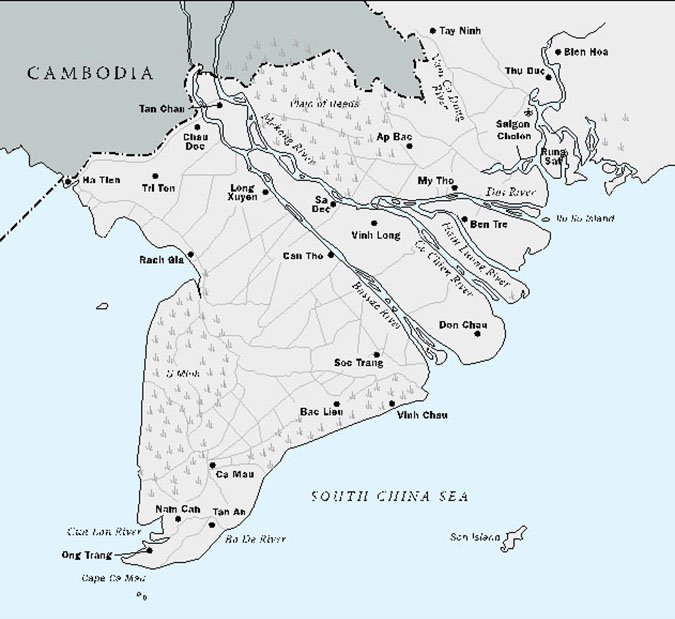Week of December 10
On December 6, 1968, the U.S. Navy launched Operation GIANT SLINGSHOT, with the goal of eliminating Communist infiltration of South Vietnam along the Vàm Cỏ Đông and Vàm Cỏ Tây rivers, near the Cambodian border—a region known as the “Parrot’s Beak,” where part of Cambodia juts into South Vietnam. The operation was an extension of the Southeast Asia Lake, Ocean, River, Delta Strategy (SEALORDS), which the Navy began several months earlier, in October.
The operation was named for the shape that the Vàm Cỏ Đông and Vàm Cỏ Tây make when they flow together to form a “V,” or, “slingshot,” just west of Sài Gòn. North Vietnamese and Việt Cộng forces had long used these waterways to quickly and efficiently move supplies, arms, and troops across the border from the Hồ Chí Minh Trail to the areas just outside the capital of South Vietnam.
GIANT SLINGSHOT was part of the wider American effort to create electronic and patrol barriers across water infiltration routes into South Vietnam. The men tasked with GIANT SLINGSHOT employed river patrol boats (PBRs), assault support patrol boats (ASPBs), fast patrol craft (PCFs, or “Swift Boats”) and other riverine watercraft to halt enemy river traffic moving across the border from Cambodia. UH-1 Huey “Seawolf” and AH-1 Cobra helicopters also provided vital support from the air. Within a month, the Sailors successfully created a patrol barrier on nearly all of the navigable waterways from northwest of Sài Gòn all the way to the Vịnh Thái Lan (Gulf of Thailand).
The Americans who supported Operation GIANT SLINGSHOT were part of the U.S. “brown water” Navy in Vietnam. Much of the region south and west of Sài Gòn featured a dense network of canals, streams, marshes, and rivers that allowed Communist forces numerous avenues to evade American troops and to strike South Vietnamese commerce, which depended on these waterways to move goods and produce. The brown water Navy—including the River Patrol Force and the combined Army-Navy Mobile Riverine Force—proved instrumental in countering the insurgency in this region.
Operation GIANT SLINGSHOT was largely effective. In the days and weeks after it began there was a significant increase in the number of firefights between U.S. and insurgent forces along the Vàm Cỏ Đông and Vàm Cỏ Tây, and U.S. patrols seized large caches of firearms, explosives, and other weapons from enemy boats and shore installations. Việt Cộng and North Vietnamese incursions from Cambodia were never wholly eliminated, however, and the problem intensified again, later in the war. The U.S. Navy passed official responsibility for GIANT SLINGSHOT to the South Vietnamese Navy in May 1970, during the “Vietnamization” phase of the war.1
1Edward J. Marolda and R. Blake Dunnavent, Combat at Close Quarters: Warfare on the Rivers and Canals of Vietnam (Washington, D.C.: Naval History and Heritage Command, 2015); Edward J. Marolda, By Sea, Air, and Land: An Illustrated History of the U.S. Navy and the War in Southeast Asia (Washington, D.C.: Naval Historical Center, 1994), 269–74; Ronald B. Frankum, Jr., Historical Dictionary of the Vietnam War (Lanham, MD.: Rowman and Littlefield, 2011), 180; Jack Sweetman, American Naval History: An Illustrated Chronology of the U.S. Navy and Marine Corps, 1775–Present (3rd edition; Annapolis, MD.: Naval Institute Press, 2002), 232; Thomas Cutler, Brown Water, Black Berets: Coastal and Riverine Warfare in Vietnam (Annapolis, MD.: Naval Institute Press, 1988), 305–6; Allan D. English, ed., The Changing Face of War: Learning from History (Montreal, Quebec, Canada: McGill-Queen’s University Press, 1998), 163.

|
3. Map of southern South Vietnam. The Vam Co Dong River is labeled, situated west of Saigon. (Naval History and Heritage Command)